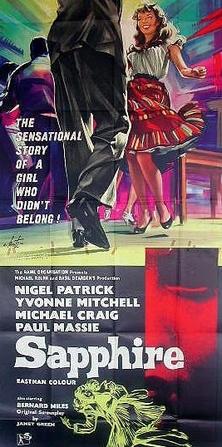Plot
Children playing on Hampstead Heath in London come across the body of a young light-skinned woman who has been stabbed to death. Police Superintendent Robert Hazard and his assistant, Inspector Phil Learoyd, follow the lead of the woman's handkerchief, monogrammed with an "S," and discover that her name was Sapphire Robbins, a music student. Her brother, a doctor working in Birmingham, is notified. Her fiance, an architecture student named David Harris, claims to have been in Cambridge at the time of the murder.
An autopsy reveals that Sapphire had been three months pregnant. The police are surprised when Dr. Robbins arrives and they see that he is black. He and his sister were mixed race, but Sapphire was able to "pass" as white. Robbins is professional in his bearing and proud, sceptical that the police will actually try to solve his sister's murder.
Investigating Sapphire's life and acquaintances, the officers find that she frequented nightclubs with black clienteles, leading them to look for another possible boyfriend. Learoyd is quick to jump to racist assumptions about the victim's behaviour, but Hazard is nonjudgemental and sometimes counters his assistant's biased views. Interviews with other possible witnesses or connections to the case reveal a range of racist attitudes in the white population.
When the officers question members of David's family, they learn that Sapphire had revealed her family background to David, and had informed his parents and adult sister Mildred about the pregnancy. David's father had reluctantly agreed to David and Sapphire marrying despite his own racist views and the family's concern about their social standing, as well as the knowledge that David would probably have to forfeit an upcoming scholarship to study in Rome.
Visiting Tulip's Club, a nightclub favoured by affluent young blacks, Hazard and Learoyd learn that Sapphire was resented by some of her contemporaries, but that she often went there with a young man called "Johnnie Fiddle". After a chase, Johnnie is caught and brought in by the police. A knife and a bloody shirt are discovered in his room, but Johnnie claims these were from a fight he had with a certain "Horace Big Cigar". In the meantime, however, David is seen acting suspiciously near the murder scene on Hampstead Heath, and it is discovered that he had returned from Cambridge earlier than he claimed on the day of the murder.
Hoping to prod further revelations from those closest to the murder, Hazard brings Dr. Robbins to the Harris home, prompting angry reactions from the family. The most violent comes from Mildred, who responds with disgust when Robbins picks up one of her daughter's toys. Mildred finally confesses to her hatred of Sapphire and to the murder. With the case wrapped up, Hazard acknowledges the larger social evils underlying the case, telling Learoyd that they "didn't solve anything... We just picked up the pieces."
Reception
Box office
According to Kinematograph Weekly , the film performed "better than average" at the British box office in 1959. [9]
Variety claimed the film earned just under $700,000 in Britain in 1959. [10]
Reportedly, it had made a profit of over £100,000 by 1961. [11]
Critical reception
Variety called it "a well knit pic... Although it hasn't anything very sensational in the way of stellar lure for houses outside of England, it is a holding yarn, acted persuasively. But, though obviously inspired by outbreak of color-bar and Nottingham, it ducks the issue, refusing to face boldly up to the problem. Thus the pic does not get its message over as effectively as it might. There is constant haggling over the problem and some snide remarks, but it eventually adds up merely to another whodunit." [12]
Josh Billings of Kinematograph Weekly wrote "I'm always a nervous of films dealing with racial discrimination, but by legitimately introducing skilfully contrived "whodunit” into this provocative subject the director and script writer of “Sapphire” have succeeded in manufacturing a purposeful and exciting thriller. The film, which had a marvellous press, has attracted all classes." [13]
At the time of the film's original UK release, Nina Hibbin of the Daily Worker commented: "You can't fight the colour bar merely by telling people it exists. You have to attack it, with passion and conviction. Commit yourself up to the hilt. Otherwise you're in danger of fanning the flames." [14]
In the US, A.H. Weiler of The New York Times wrote that, while the film is "not entirely in a class by itself, the combination of murder mystery and racial issues puts it several interesting cuts above standard movie melodrama". [15]
Variety called the film a "Sound murder drama which compromises uneasily on question of color discrimination. Though obviously inspired by last year's outbreak of color-bar riots in London and Nottingham, it ducks the issue, refusing to face boldly up to the problem. Thus the pic does not get its message over as effectively as it might. There is constant haggling over the problem and some snide remarks, but it eventually adds up merely to another whodunit." [16]
The reviewer for the British Film Institute's Screenonline website wrote: "Dearden is not immune to prevailing prejudices, equating a young woman living alone in London with promiscuity, and seeing an enthusiasm for jazz as evidence of dubious character. The film is littered with casual, unchallenged racism". [14]
Filmink noted the movie "has been completely overshadowed by that team’s later Victim, but it is an interesting tale and it was a big hit. You can’t beat a murder mystery as an effective, crowd-pleasing way to explore societal problems." [17]
This page is based on this
Wikipedia article Text is available under the
CC BY-SA 4.0 license; additional terms may apply.
Images, videos and audio are available under their respective licenses.
